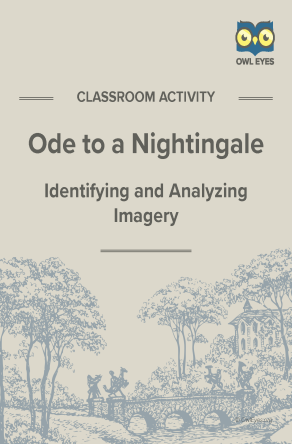Ode to a Nightingale Imagery Activity
- 8 pages
- Subject: Imagery, Literary Devices, Tone, Lesson Plans and Educational Resources
- Common Core Standards: RL.11-12.1, RL.11-12.4, RL.11-12.5, RL.9-10.1, RL.9-10.4
Additional Ode to a Nightingale Resources
Product Description
John Keats penned “Ode to a Nightingale” in 1819 in a burst of creativity that produced four other now-classic odes. The poem is a sustained meditation about death, with which Keats’s speaker has a conflicted relationship. “Ode to a Nightingale” contains some of Keats’s most accomplished uses of imagery. Through a vast and varied range of images, Keats evokes all five of our senses as he weaves his wide-reaching ruminations on oblivion.
Skills: analysis, drawing inferences from text, close reading, identifying the relationship between words
About This Document
The Owl Eyes Imagery activity gives students an opportunity to practice identifying and analyzing imagery. Imagery within a text creates a sensory experience that can connect readers to a text’s setting, atmosphere, or overall aesthetic. Studying imagery will help students understand how narrators or principal characters feel. The main components of this worksheet include the following:
- A brief introduction to the text
- A handout on types of imagery with examples from classic texts
- A step-by-step guide to activity procedure
- Selected examples of imagery from the text
In completing this worksheet, students will learn to identify and analyze different kinds of imagery in order to develop close reading skills and identify the effect imagery has on their reading experience.







